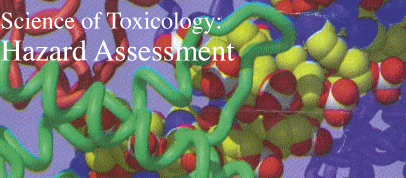
Risk Assessment is another type of causation: predicting whether an exposure, usually in a population rather than a single individual, will increase the risk of developing some adverse health effect, without necessarily determining whether such health effect actually occurs. Risk means that all such exposed individuals are more likely to develop an adverse effect, but it does not mean that any particular individual will or even that the majority of individuals will. Smoking, for example, increases risk of lung cancer from approximately one in 100 to 1 in 10--a signficiant increase. Nevertheless, ninety percent of smokers do not develop lung cancer, even though they are all at increased risk. Risk Assessment is used by regulatory agencies, such as the EPA, to determine how much of a chemical can be released into the environment without causing an unacceptable increase in risk of an adverse effect. 'Unacceptable' is more of a policty decision than a scientific one.
Specific causation analysis can be divided into the following three components:
(1) Hazard Assessment
(2) Exposure Assessment
(3) Health Assessment
(1) Hazard Assessment: what harm can the chemical cause, based on intrinsic toxicity and circumstnaces of exposure, form of chemical (gas, liquid, solid) and susceptibility of individual.
(2) Exposure Assessment how much of the chemical is in a media (air, water, food, soil) available to be taken into the body? Is this a one-time or multiple exposure? Does it occur over a short period of time (acute) or over many months or years (chronic)? How does the length of exposure affect the toxicity of the chemical? How much of the chemical gets absorbed into the body (dose), and where in the body does it end up (distribution and target organ/tissue)?
(3) Health Assessment: what type of health effect develops (or gets exacerbated), and does this occur immediately or after a delay (lag time)? Is this a new effect in the individual or is there a history of this type of problem, made worse by the chemical exposure? Is the individual in a high risk group (in utero, infant, elderly, reduced immune function)? Are there other (alternative) known causes for this problem and were these causes present ?
Hazard Assessment

Hazard Assessment identifies whether a chemical--mercury, lead, manganese, PAH, endocrine disruptors, pesticides--is capable of causing adverse effects and the circumstances under which this occurs. (This compares to toxicity, which is the intrinisic ability for a chemical to cause an adverse effect, but which it may not if properly stored.) Ultimately, all chemicals can do so if the dose is large enough--even water or oxygen. The underlying principle of toxicology is 'the dose makes the poison'. This site is concerned with the toxicity of chemicals which, at concentrations that would normally be encountered in daily life or in the work place, either for use or in storage, or at lower concentrations, can cause an adverse health effect. Those are the chemicals that are the primary focus of toxicology and of this section. Hazard information is derived from epidemiological studies, animal studies, in vitro studies, case reports and medical experiments. Often the data is derived from occupational exposures which does not necessarily apply to non workers as the exposure conditions and degree of susceptibility may be quite different.